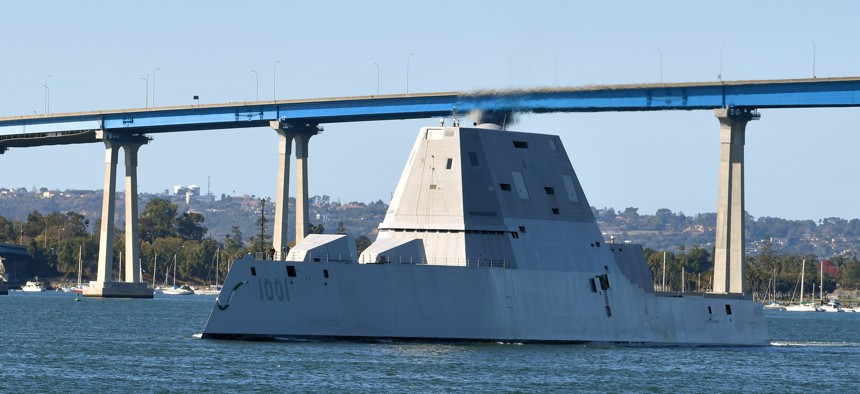
This is USS Michael Monsoor, a DDG 1000-class destroyer. The Navy wants a hull that's even more advanced for its proposed DDG-X. Mass Communication Specialist 1st Class Jacob I. Allison
New Destroyer, Armed With Lasers and Hypersonic Missiles, Envisioned as Navy’s Future Centerpiece
U.S. admirals made the case for the new ship during a virtual conference this week.
The U.S. Navy is eyeing a new class of warship to replace its current Arleigh Burke destroyers — ships that can fight by themselves using lasers and hypersonic missiles.
This DDG-X is needed, a chorus of admirals argue, to stay a step ahead of Chinese and Russian missile advances.
“As our adversaries push farther and farther from their shores, we need a ship that can generate enough power to drive more sophisticated radars, electronic warfare systems and directed energy weapons — a ship that will be able to competently operate inside adversary weapon engagement zones,” Rear Adm. Paul Schlise, who leads the Navy staff’s Surface Warfare Division, said Tuesday.
Speaking at the virtual Surface Navy Association conference, Schlise and other Navy brass made the case for this new warship, newly dubbed DDG-X. (It’s previously been called DDG-Next and the Large Surface Combatant.)
“We look to large and energetic hypersonic missiles to remind those adversaries that no target is out of range, at least not for long,” Schlise said. “We need to ship to achieve these goals.”
The new destroyer is part of the Navy’s long-term goal of increasing its fleet size. Trump administration officials in recent months have drafted blueprints for increasing Navy spending to achieve this goal. The officials believe a larger sea service with more ships is necessary to compete with China in the Pacific, something echoed by military leaders this week.
“The Navy’s strategic direction remains clear,” Adm. Mike Gilday, the chief of naval operations, wrote in the CNO NAVPLAN, the latest in a series of reports by uniformed and political leaders calling for a larger fleet. “We are engaged in a long-term competition that threatens our security and way of life.”
Navy officials argue that while their current Arleigh Burke destroyers will remain lethal and relevant for years to come, they lack the room and electrical power to accommodate the weapons of the future. The ship’s combat system “will be the foundation” for the DDG-X, Schlise said.
“We've done about all we can do with this ship and we've maxed out the space, weight, power and cooling,” he said. It's time to reset to a new large surface combatant hull.”
Even the two-decades-younger DDG-1000 hull won’t do, Schlise said. “We are looking at a new hull form with a new propulsion plant and the ability to incorporate…an integrated power system that has the ability to power up the weapons and sensors of the future,” he said. “I think the integrated power system is the key to the realm here.”
The ship “will give us the ability to operate confidently and increasingly contested environments,” Vice Adm. James Kilby, deputy chief of naval operations for warfighting requirements and capabilities, said at the same conference on Monday.
“DDG-X will give us considerable upgrades from the addition of larger, more dynamic missiles that will hold targets at risk at longer ranges,” Kilby said.
The Navy plans to follow the same buying blueprint it used to accelerate the purchase of new frigates last year, Schlise said, although that ship is based on an existing design already in service with the Italian and French navies. And it plans to test DDG-X’s power plant on land before installing it in a floating hull.
The new ship is expected to cost $2.5 billion, Bryan Clark, a Hudson Institute naval analyst, wrote in Forbes.




